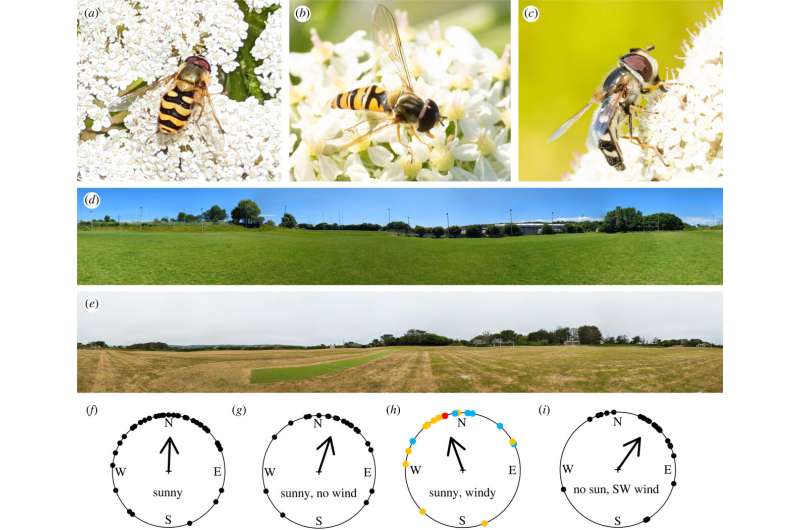(a–c) Photographs of migratory hoverflies taken on the Isles of Scilly prior to capture. (a) Syrphus vitripennis, (b) Episyrphus balteatus, (c) Scaeva pyrastri. (d) A 360° panoramic photo of the Penryn site on the day of release in sunny conditions. (e) A 360° panoramic photo of the Isles of Scilly study site on the day of release under thick sea mist conditions. (f–i) Circular histograms of individual vanishing bearings (black dots) and group mean directions (black arrow) with length of the arrow depicting r from 0 to 1 at the outer edge of the circle. (f) All hoverfly headings while sunny. (g) Hoverfly headings with no wind when sunny. (h) Hoverfly headings while it was windy and sunny. Yellow dots indicate a south-southeasterly wind, blue dots indicate a westerly wind, red dot indicates an easterly wind. (i) Hoverfly headings during a thick sea mist when the sun was obscured, with wind from the southwest. Credit: Biology Letters (2022). DOI: 10.1098/rsbl.2022.0318
A team at the University of Exeter has shown experimentally for the first time, that hoverflies migrating during the spring orientate north.
In late spring earlier this year, a large-scale migration of insects arrived on the Isles of Scilly and mainland Cornwall. Species included many migratory butterflies and moths such as the Painted Lady and Hummingbird Hawkmoth, but the majority of the arrivals were Hoverflies.
These hoverflies were of a variety of species, but the main insect observed in the experiment was the glass-winged Syrphus (Syrphus vitripennis). Analysis of wind conditions revealed that the insects had most likely flown across the channel from Western France, a minimum distance of 200km.
"Sat in a field on the beautiful Isles of Scilly, I could hardly believe it. Nearly every single hoverfly we released flew purposefully north, as if pulled by a magnet," says Will Hawkes, Ph.D. student from the University of Exeter's Center of Ecology and Conservation at the Penryn Campus in Cornwall.
To perform the experiment, the researchers caught the hoverflies feeding on flowers before taking them to wide-open fields on both the Isles of Scilly and in mainland Cornwall.
The hoverflies were then released, crawling up the researcher's finger, spending a few seconds to orientate themselves before flying off, nearly always towards the north. The hoverflies were flown in cloudy and sunny conditions, with and without the presence of wind, and on all occasions the mean direction was to the north. This provides the first experimental confirmation of a northerly compass sense in springtime migrating hoverflies.
"Studying insect migration is crucial if we are to fully reap the benefits of the ecological roles insects perform, from pest controllers and decomposers to pollinators. Understanding their routes and orientation mechanisms will help conservationists protect the large-scale movements of these insects," remarks Dr. Karl Wotton, Senior Lecturer at the University of Exeter, and a Research Fellow at the Royal Society University.
The paper is published in Biology Letters.
More information: Will L. Hawkes et al, Migratory hoverflies orientate north during spring migration, Biology Letters (2022). DOI: 10.1098/rsbl.2022.0318
Journal information: Biology Letters
Provided by University of Exeter
























